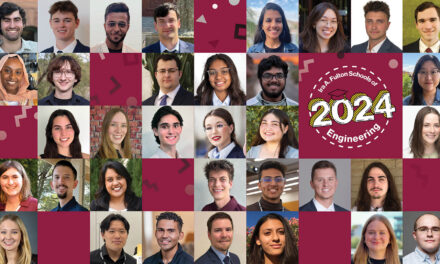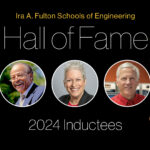
Mimicking nature to enhance search for knowledge underground

Above: Associate Professor Junliang “Julian” Tao is one of 10 Ira A. Fulton Schools of Engineering faculty members to receive an National Science Foundation CAREER Award for 2018 to 2019. He is exploring unique methods of mobility animals and plants use to move underground.
Ten faculty members in the Ira A. Fulton Schools of Engineering have received NSF CAREER Awards between September 2018 and April 2019.
As Junliang “Julian” Tao sees it, humans have made remarkable progress in technologies for transport over land, in water and across the sky, but have achieved comparatively less in creating ways to move things around underground.
Tao aspires to change that by integrating knowledge of geotechnical engineering, robotics and biology to develop methods and tools that enable more effective access into subterranean environments.
With support from a National Science Foundation Faculty Early Career Development Program (CAREER) Award, the associate professor of civil, environmental and sustainable engineering in Arizona State University’s Ira A. Fulton Schools of Engineering, will strive to formulate new designs for technology that replicate the impressive subsurface mobility that evolution has produced in the living world, specifically that of plants and animals.
Many creatures have adapted to survive underground by developing unique abilities to navigate through soil. Tao will work on fashioning bio-inspired burrowing robots to do what worms, lizards, clams, moles and other small reptiles, amphibians, mammals, plant seeds and roots do to thrive beneath the surface.
As a model for the first of these robots, Tao will focus on the razor clam whose self-transport talents encompass a mix of methods exhibited by burrowing animals — and does so with particular speed and precision by using its shell and foot to dig into the ground.
Razor clams have another ability that serves to protect them, Tao explains. They can sense vibrations from movements on and in the ground in the area around them, which alerts them to flee potential threats.
Tao’s robots will be able to do something similar using sensors. The purpose won’t be for the robots to escape predators. Instead, the sensors will provide information about soil conditions, making them valuable tools for monitoring soil contaminants, planning underground construction and ensuring infrastructure safety and precision land use for agriculture, among myriad related endeavors.
By adding more sensors and actuators, the robots will also be able to communicate with each other underground.
Tao will extract knowledge to compose blueprints for how the robots can imitate animals’ efficiency both in technique and in using relatively minimal amounts of energy to burrow by closely examining ways animals excavate, wiggle, vibrate and push to locomote through soils.
“The main things we want to know are how their body motions determine the effectiveness and efficiency of their movements through soil, and what kinds of motions work best in penetrating certain types of soil,” says Tao, who teaches in the School of Sustainable Engineering and the Built Environment, one of the six Fulton Schools.
Accomplishing those goals will enable Tao to design burrowing robotic sensor devices that provide more accurate geotechnical surveys and mapping of soil properties, which will aid efforts to protect communities from some of the impacts of earthquakes and floods. It will also help in the development of design and construction techniques to ensure more efficient and autonomous construction, and to improve environmental management strategies.
What Tao discovers through his research will be shared with students and the public in a variety of ways.
In August of 2018, after five years at the University of Akron, Tao joined the Fulton Schools and ASU’s Center for Bio-mediated and Bio-inspired Geotechnics, an NSF Engineering Research Center pursuing geotechnical innovations inspired by nature. Now, as part of his NSF CAREER Award project, he is collaborating with the outreach and education team in CBBG to create a mobile interactive demonstration exhibit and an adaptable lecture module to teach a diverse range of young students and community members about burrowing technologies.
Tao is also collaborating with the Biomimicry Center at ASU on joint educational efforts to showcase the growing connections between biology, technology and engineering.
This semester, Tao introduced a new course in the Fulton Schools focused on bio-inspired design applied to geotechnical engineering and civil engineering. Nearly 30 students registered.
“That’s a surprise” for such a new and different course, Tao says, “but I think it shows people are realizing that breaking down barriers between academic disciplines is what is needed to overcome today’s complex engineering challenges.”




































